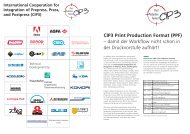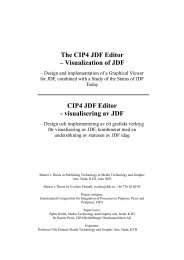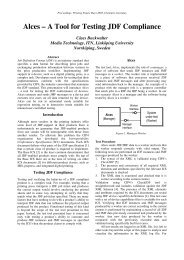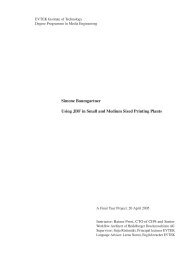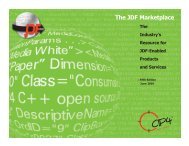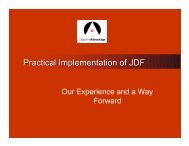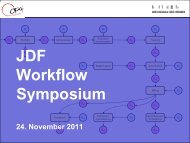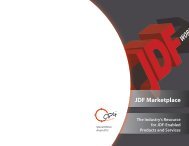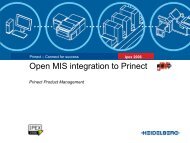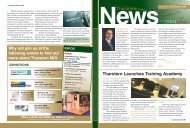September 2009 JDF Marketplace - CIP4
September 2009 JDF Marketplace - CIP4
September 2009 JDF Marketplace - CIP4
You also want an ePaper? Increase the reach of your titles
YUMPU automatically turns print PDFs into web optimized ePapers that Google loves.
Introduction<br />
In our industry there are a variety of sizes and types of MIS systems ranging<br />
from enterprise-wide systems that may incorporate management reporting<br />
�����������������������������������������������������������������������<br />
prepress operations.<br />
At their most basic, these systems must be able to accept <strong>JDF</strong> input and<br />
decompose the <strong>JDF</strong> and store the data in its internal database, and they<br />
���������������������������������������������������������������������<br />
��������������������������������������������������������������������������<br />
cannot output <strong>JDF</strong> may prove to be roadblocks to your process automation<br />
program.) This requirement implies that these systems must be able to<br />
read and validate <strong>JDF</strong>, as well as write and validate <strong>JDF</strong>.<br />
Validation is the process of checking a <strong>JDF</strong> instance against the public <strong>JDF</strong><br />
schema or a working subset to ensure that the rules of structure are adhered<br />
to. Some companies may integrate validation functions, while others<br />
may use a third-party tool. It’s important to know that not any off -the-shelf<br />
XML schema validation tools can be used. In the <strong>JDF</strong> specifi cation there are<br />
certain “if-then” conditions that an off -the-shelf generic validator will not be<br />
able to validate. If an output ICC color profi le is associated with an image<br />
that is incorporated into a document fi le that also has an output ICC color<br />
profi le, and those two profi les don’t match, the document’s output color<br />
profi le takes precedence and you may have to apply a transformation to<br />
the image. Conditions such as these are common to the graphic arts, and in<br />
the <strong>JDF</strong> specifi cation you’ll see many cases where a default is established at<br />
������������������������������������������������������������������������������<br />
tors, available from <strong>CIP4</strong> as well as commercial sources, take these “if-then”<br />
conditions into account, as do embedded systems that many vendors are<br />
building into their <strong>JDF</strong> “MIS” systems.<br />
�����������������������������������������������������������������������<br />
�����������������������������������������������������������������������������<br />
jectives of process automation and computer-integrated manufacturing.<br />
���������������������������������������������������������������������<br />
must understand, read, and write JMF (more information below), and must<br />
be able to store and utilize the input and parameter requirements of each<br />
�������������������������<br />
�����������������������������������������������������������������������<br />
must be able to organize a <strong>JDF</strong> job. <strong>JDF</strong> uses a very “Lego-like” approach to<br />
���������������������������������������������������������������������������<br />
individually to which you can associate several “resources.” There are about<br />
160 resources specifi ed in JDA and they are input and output parameters<br />
(metadata) that can be associated to a process.<br />
Resources: Forming the Link Between Process “Nodes”<br />
�����������������������������������������������������������������������������<br />
hence, the singular term “resource.” Once all of the required inputs for a<br />
����������������������������������������������������������������������������<br />
��������������������������������������������������������������������������<br />
ter is an image plate, and that image plate is the input to a press. The press<br />
cannot begin operating until the plate is imaged. Even legacy systems<br />
without on board computers and manual tasks can be managed this way.<br />
There are several features in <strong>JDF</strong> that can be used optionally to accom-<br />
�������������������������������������������������������������������������<br />
spawning and merging of jobs. This feature may be used where several<br />
diff erent signatures print concurrently on diff erent presses, or a cover is<br />
������������������������������������������������������������������������<br />
can create “combined process” that acts as one with one set of inputs and<br />
outputs in a pipeline. For instance, many digital printing devices consist of<br />
a combined RIP, printer and fi nishing unit, and yet there is only one set of<br />
inputs and outputs. A conventional print job is actually a combined process,<br />
in that you may have ink, paper, cutting, color measurement and other<br />
processes running concurrently. An ink system may use a special variant<br />
������������������������������������������������������������������<br />
the ink well or tank hits a lower level, the inking system goes off -line until it<br />
��������������������������������������������������������������������������������<br />
These are options you may want to be aware of when selecting a <strong>JDF</strong> MIS or<br />
������������������<br />
Introduction<br />
17




